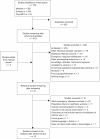Acceptance of a pandemic influenza vaccine: a systematic review of surveys of the general public
- PMID: 22114512
- PMCID: PMC3215344
- DOI: 10.2147/IDR.S23174
Acceptance of a pandemic influenza vaccine: a systematic review of surveys of the general public
Abstract
Introduction: The effectiveness of pandemic vaccine campaigns such as the H1N1 vaccine rollout is dependent on both the vaccines' effectiveness and the general public's willingness to be vaccinated. It is therefore critical to understand the factors that influence the decision of members of the public whether to get vaccinated with new, emergently released vaccines.
Methods: A systematic review of English language quantitative surveys was conducted to identify consistent predictors of the decision to accept or decline any (pre)pandemic vaccine, including the H1N1 influenza A vaccine. A total of ten studies were included in this review and all pertained to the 2009 H1N1 influenza A pandemic. Respondents' willingness to receive a pandemic vaccine ranged from 8%-67% across the ten studies. The factors reported to be consistent predictors of the intention to vaccinate were: risk of infection, proximity or severity of the public health event, severity of personal consequences resulting from the illness, harm or adverse events from the vaccine, acceptance of previous vaccination, and ethnicity. Age and sex were the demographic variables examined most frequently across the ten studies and there was no consistent association between these variables and the intention to accept or reject a pandemic vaccine.
Conclusion: Some predictors of the intention to accept or decline a (pre)pandemic vaccine or the H1N1 influenza A vaccine are consistently identified by surveys. Understanding the important factors influencing the acceptance of a pandemic vaccine by individual members of the public may help inform strategies to improve vaccine uptake during future pandemics.
Keywords: H1N1 influenza A; demographic; emergent vaccine; pandemic; personal risk.
Figures
References
-
- Jupp V. The Sage Dictionary of Social Research Methods. London: Sage Publications; 2006.
-
- Mills E, Jadad AR, Ross C, Wilson K. Systematic review of qualitative studies exploring parental beliefs and attitudes toward childhood vaccination identifies common barriers to vaccination. J Clin Epidemiol. 2005;58(11):1081–1088. - PubMed
-
- Rubin GJ, Potts HW, Michie S. The impact of communications about swine flu (influenza A H1N1v) on public responses to the outbreak: results from 36 national telephone surveys in the UK. Health Technol Assess (Winchester, England) 2010;14(34):183–266. - PubMed
-
- Maurer J, Uscher-Pines L, Harris KM. Perceived seriousness of seasonal and A (H1N1) influenzas, attitudes toward vaccination, and vaccine uptake among US adults: does the source of information matter? Prev Med. 2010;51(2):185–187. - PubMed
LinkOut - more resources
Full Text Sources


